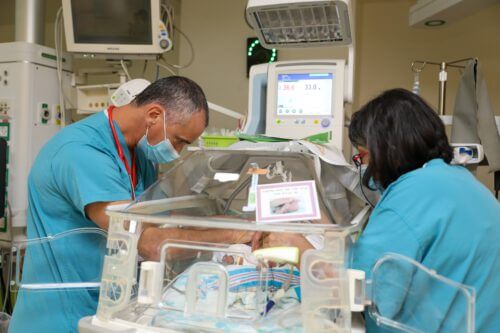Many premature babies need various treatments that support the body systems that have not yet developed, or did not develop properly, before their premature birth. One of the common treatments for premature babies is the need for ventilator support. The question is whether to perform invasive or non-invasive ventilation?

Has the controversy that has existed for years in the world of preterm medicine come to an end? A new and ground-breaking Israeli study reveals data, which make it possible, for the first time, to receive answers that may change the way premature babies are treated around the world.
Respiration in premature infants can be performed by invasive respiration with the insertion of a tube into the trachea - in cases of severe distress of the premature infant, or by non-invasive respiration, which uses a machine that keeps the lungs open and flows the oxygen through tubes that are inserted into the tiny nose of the premature infant. However, even the method that is considered less aggressive - the one with the tubes inserted into the nose, is not without problems - the rigid tubes can cause damage, and rarely even significant damage, to the nose of the premature baby. In recent years, a technique has entered the market that uses a thinner and more delicate tube that reduces the damage to the premature nose, but two camps have emerged - those who prefer the hard tubes, which are thought to provide better support to see, and are popular today with most premature babies in the world, and those who prefer the thin and delicate tubes.
Now, a first-of-its-kind clinical study conducted by Israeli researchers presents new data, proving that premature babies can be feminized effectively and without harming their delicate faces. The study was recently published in the prestigious scientific magazine JAMA Pediatrics and enables a significant change in the daily care of many babies who need respiratory support.
The aggressive method may cause injury to the newborn
"The prevailing opinion among doctors is that the use of the thick and stiff tubes allows better transmission of respiratory pressure and support for premature babies, compared to the use of thin tubes," explains Dr. Uri Hochwald, a senior doctor in Rambam's Prematurity Department, who heads the study. "The methods were previously tested on Models various that led to these conclusions, but no one has ever tested the subject on Patients. In some cases, the premature babies who were breathed using the more aggressive method were injured by the tubes in their noses, sometimes significant injuries that would take time to recover from, but the idea was to avoid invasive breathing that involves greater risks, so these injuries were in some cases the least of the worst."
The study, which was led by Rambam researchers (Dr. Hochwald and Prof. Amir Kugelman), was done in collaboration with the Bnei Zion Medical Center in Haifa (led by Prof. Eric Riskin) and surveyed 166 premature babies who needed non-invasive ventilation. The premature babies were randomly divided into two groups, each of them received treatment with non-invasive ventilation using one of the usual methods, when the goal of the study was the ability to avoid the need to switch to invasive ventilation, at least for 72 hours, in order to declare the treatment successful and effective.
"This is a non-inferiority study," notes Dr. Hochwald. "The intention is that we do not test which of the methods is better, but prove that one is no less good than the other", and adds, "in other words, we wanted to prove that the new, gentler method is no less effective than the prevailing method".
From the processing of the data of the premature infants examined, it emerged that in the group of ventilation using the thick tubes, which is commonly used in premature infants around the world, the percentage of treatment success according to the established criteria was 82%. The second group, the one in which the thin tubes (the new method) were used, showed a success rate of 86%, according to the same criteria, and with a significantly lower percentage of injury to the patients' noses.
"The significance of the research results is that we were able to prove, for the first time, that the controversial method is just as effective as the prevailing one," says Dr. Hochwald. "It sounds like something minor, but for the care teams, the babies and the families, this is a figure that allows for a significant improvement in the treatment of premature babies. This is another tool, non-invasive and less harmful than the treatments used for delicate premature babies who need breathing. Until today, because of the decisions that were based on tests in models, many premature babies were not ready to use this method because they thought it was less effective. Now there is proof. Since we are talking about treatment that most premature babies will receive at one point or another, this is an important step for everyone."
